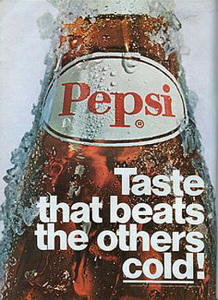THE CLAIROL CO. * “Give Your Hair That Summer Look!” * 1968
![]()
 From the MCRFB news archive: 1967
From the MCRFB news archive: 1967
NEW YORK — There’s another world that has been reaping rewards from hit records — the radio and TV commercial field. Often, the approach is direct, such as such as the tie-in Petula Clark has with Plymouth in which she promotes the automobile in song on both radio and TV; one of her hits was re-written slightly to mention the car. Other times, the approach is subliminal; for example, countless commercials today feature a mariachi sound in the music, capitalizing on the success of Herb Alpert.
Many recording artists earn large figures performing, writing, or producing commercials for Madison Avenue advertising agencies. Joe Harnell, Columbia Records, scored quite well in the advertising field. Ellie Greenwich, who records on United Artists Records but is better known as a songwriter, has produced or helped produce several commercials, including “Summer Blonde,” by Clairol.
At the same time, there has been a lot of reverse hits. A commercial written by Sid Ramin for Pepsi-Cola, handled by BBD&O, was recorded by the Bob Crewe Generation and became a million-seller — “Music To Watch Girls By.” Sascha Burland’s Alka-Seltzer commercial for McCann-Erikson — “No Matter What Shape Your Stomach’s In,” was a hit a couple of years ago by the T-Bones.
Today, when an advertising firm does a commercial, it immediately thinks of its potential as a record, hoping for that subliminal exposure. Columbia Records released “Girl From Breadsticks,” a Stella D’Oro commercial, last summer.
More and more advertising agencies are realizing that the rock ‘n’ roll field is where the action is and is either using the group themselves in commercials or using the same sounds. A good copyright can reap extra profits for a publisher when an advertising firm picks it up, with altered lyrics, for a commercial. “Georgie Girl,” became thus, became a good vehicle for White Rock soda. “White Rabbit,” a hit by Jefferson Airplane on RCA Victor, became a white Levis commercial.
Battle For Teens
For a while, Coca-Cola and Pepsi-Cola were battling it out for the teen market by using rock ‘n’ roll artists in their commercials. McCann-Erikson used artists like Sandy Posey, the Supremes, Ray Charles, Neil Diamond, and the New Vaudeville Band. Dick Harvey at McCann-Erikson said these commercials, which generally combined a hit song by the artist, were “the best thing we did for the teen market.”
 Hilary Lipsitz, vice-president at BBD&O, has found that rock groups work extremely well for the teen market for Pepsi. The firm bowed a promotion package a while back for bottlers that include a film by the Turtles in a recording session of their summer themed — “Taste That Beats The Others Cold.” The promotion package also include an album of radio spots featuring the Turtles, Jackie DeShannon, and Martha and The Vandellas, as well as a TV film of the Four Tops in action with the theme. Lipsitz, an account group head, has made it a point to know a lot of people in the music business.
Hilary Lipsitz, vice-president at BBD&O, has found that rock groups work extremely well for the teen market for Pepsi. The firm bowed a promotion package a while back for bottlers that include a film by the Turtles in a recording session of their summer themed — “Taste That Beats The Others Cold.” The promotion package also include an album of radio spots featuring the Turtles, Jackie DeShannon, and Martha and The Vandellas, as well as a TV film of the Four Tops in action with the theme. Lipsitz, an account group head, has made it a point to know a lot of people in the music business.
Leslie Miller, an artist signed to M-G-M Records, has worked on commercials for everything from Coke to Aqua Velva to Falstaff Beer. Her salary, from commercials alone, runs in a high five-figure salary category annually. For McCann-Erikson and Coke, she sang background for Lesley Gore and Neil Diamond, among others. But in many cases name artists comes too expensive and Leslie Miller has to imitate a sound or innovate her own. To sound like the Supremes, for example, she calls up two other girls, one is Valerie Simpson, who has written and sung for Motown.
There are many creative people in the recording field who are involved in producing commercials, Leslie Miller said. She mentioned John Barry, whom she worked with on an Eastern Airlines commercial; Stan Applebaum, a producer at Warner Brothers Records, and her husband, Alan Lorber. Some of the other record men who work in the commercials field include George Martin, who produces the Beatles, and Billy Strange.
Called Flights
Commercials are called “flights.” Bob Walker, account executive at Doyle Dane Bernbach, said he had four flights slated in 1967, including a Thom McAn jingle. One of their commercials were so successful that kids wrote in wanting to buy a record of it. A March Monkees’ Boots flight sold out the particular line. Like nearly every advertising executive, Walker said he would be very happy to see a commercial turn into a hit record.
Many agencies spend up to 10,000 dollars on flights, depending on the cost on the name artist involved. Doyle Dane Bernbach was one of the first agencies to use pop record acts, signing Chubby Checker in 1958.
Clay Warnick, head of the music of Young and Rubicam, pointed to Stan Applebaum, Buddy Reed, Jimmy Fagus, and Sid Ramin. He pointed out that firms might run into a problem trying to use a legit “rock ‘n’ roll sound because the wailing guitar sounds often hide the lyric message. So he has often gone to other route –using a singer like Dee Dee Warwick or Leslie Miller to create the sound of a hit. “But you have to be good to duplicate a sound because the kids recognize anything phony.”
The groups that mean anything as a name want such astronomical sums of money, that advertising agencies are worried the client may not feel they’re getting their moneys worth, said Warnick. “What you generally have to use is a reasonable facsimile of the sound.”
You have to steer things to the market for which you’re aiming the product, said Bob Nash, music director of Foote, Cone, and Belding. He personally felt the Tijuana sound was overdone, “but it was a way of reaching everyone at once.” END
(Information and news source: Billboard; November 25, 1967).
![]()